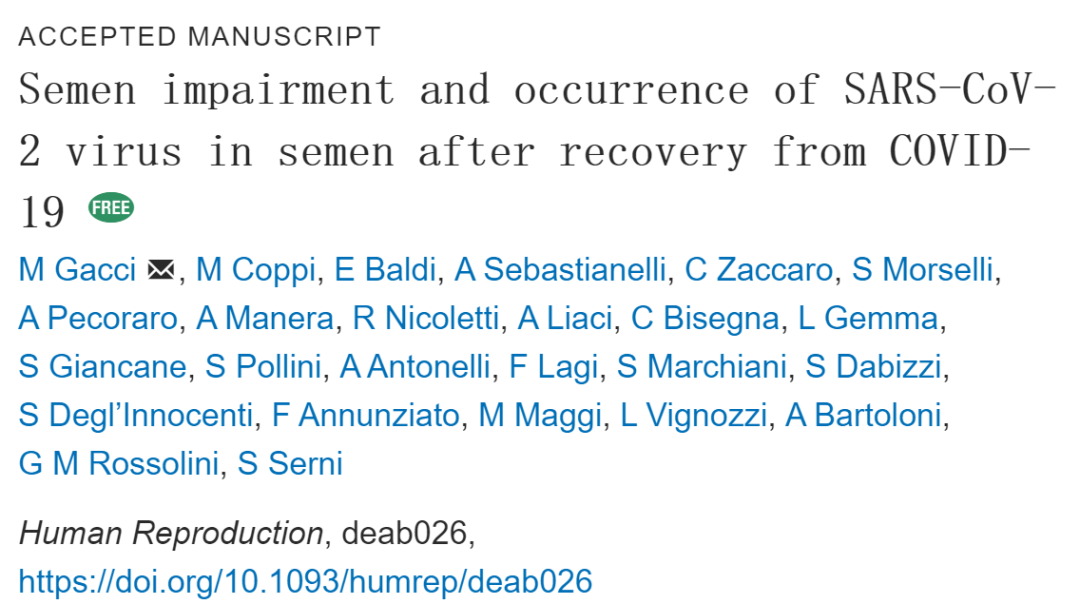COVID-19: nearly 20% of recovered men developed into azoospermia!
- Normal Liver Cells Found to Promote Cancer Metastasis to the Liver
- Nearly 80% Complete Remission: Breakthrough in ADC Anti-Tumor Treatment
- Vaccination Against Common Diseases May Prevent Dementia!
- New Alzheimer’s Disease (AD) Diagnosis and Staging Criteria
- Breakthrough in Alzheimer’s Disease: New Nasal Spray Halts Cognitive Decline by Targeting Toxic Protein
- Can the Tap Water at the Paris Olympics be Drunk Directly?
COVID-19: Italian scholars found that nearly 20% of recovered men developed into azoospermia!
COVID-19: nearly 20% of recovered men developed into azoospermia! The new coronavirus (SARS-CoV-2) usually infects humans through the respiratory tract and causes damage to the respiratory system. However, subsequent studies have found that the heart, esophagus, kidneys, liver, eyes, bladder, digestive system, and even the brain can all be infected by the new coronavirus. Virus infection can be said to be able to fully attack all organs and tissues of the human body.
As early as February 2020, Fan Caibin of the Department of Urology, Suzhou Hospital Affiliated to Nanjing Medical University and others published a paper on the preprint platform medRxiv, pointing out that the testis may be a potential target of the new coronavirus [1]. Later, researchers from the Center for Reproductive Medicine, Zhongnan Hospital of Wuhan University published a paper on the preprint platform medRxiv, and clinically observed hypogonadism in male patients with new coronavirus disease [2].
However, for male patients who have recovered from new coronavirus pneumonia, it is still unclear whether the new coronavirus is present in the semen, its role in the spread of the virus, and whether the quality of sperm is affected, etc.
Recently, Mauro Gacci and others of the University of Florence, Italy, published a research paper titled: Semen impairment and occurrence of SARS-CoV-2 virus in semen after recovery from COVID-19 [3] in Human Reproduction magazine.
This study found that 25% of men who recovered from the COVID-19 infection had azoospermia or oligospermia, which reminded us that semen quality should be assessed for those recovering from COVID-19 pneumonia of childbearing age.

The research team recruited 43 known sexually active men who have recovered from the new coronavirus pneumonia, aged 30-64, to test their saliva, urine before ejaculation, semen and urine after ejaculation to determine whether There are also new coronavirus genomes (if any samples are found to be positive for the new coronavirus, their partners will be retested), and they have also undergone routine semen analysis and semen leukocyte and interleukin 8 (IL-8) levels.
The test results showed that of the 43 sexually active men who recovered from the new coronavirus pneumonia, 11 (25%) had semen damage, of which 8 had azoospermia and 3 had oligospermia. These people are significantly related to the severity of the new coronavirus pneumonia at the time.
A total of 33 patients (76.7%) had pathological levels of interleukin 8 (IL-8) in semen.
In addition, 3 people (7%) had at least one sample (saliva; urine before ejaculation; semen; urine after ejaculation) tested positive for COVID-19, so the researchers re-tested nasopharyngeal swabs and rhinitis swabs the next day Tests showed that the three and their partners were negative for the new coronavirus.
In general, this study shows that a small percentage (7%) of men who have recovered from the new coronavirus pneumonia can detect the new coronavirus genome in their saliva, urine, and semen, but the rhinitis swab test is negative.
More importantly, as many as one-quarter of men after recovery have azoospermia or oligospermia, which reminds us that semen quality assessment should be carried out for those recovering from new coronavirus pneumonia of childbearing age.
The research team also pointed out that although the rate of azoospermia and oligospermia found in men who have recovered from the new coronavirus pneumonia is very high, which significantly exceeds the rate in the general population, the quality of the semen of these men is not yet known, nor It is clear whether these symptoms will continue to recover. In addition, the sample size of 43 people is small, which may affect the statistical results.
(source:internet, reference only)
Disclaimer of medicaltrend.org



